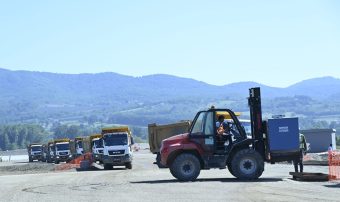Ministry of Construction, Transport and Infrastructure
The Moravian Corridor will be fully completed at the end of 2025 or at the beginning of 2026, and by the end of this year, 30 kilometers of that corridor will be open to traffic, which will include Trstenik and Vrnjačka banja, as well as part of the Preljina – Adrani section, most likely by Mrcajevac.
Goran Vesić, Minister of Construction, Transport and Infrastructure, pointed out that the length of the Moravian Corridor is 112.4 kilometers.
“There were two sections here, from Preljina to Mrcajevac and from Mrcajevac to Adran, one is 12 kilometers and the other is 18 kilometers. We are working to complete some of those sections. In any case, at the end of 2025 and the beginning of 2026, we will have those additional 25 kilometers from the Vrnjačka spa to Adran, and then the Moravian Corridor will be completely completed,” said Vesić.
As he says, the Moravian Corridor is important for the development of local tourism and local investments, and almost 30 kilometers of Western Morava are being relocated.
As he stated, almost 500,000 people live here, we have big cities such as Kraljevo, Kruševac, Vrnjačka banja and Trstenik, and it is necessary to bring some more factories to Kraljevo.
Visiting the works on the interchange Adrani sectors 3 of the Moravian Corridor, he stated that a high-speed road to Novi Pazar will begin on that interchange.
As he explained, it is about 84 kilometers that are now being designed. The high-speed road Kraljevo – Raška – Novi Pazar will connect Novi Pazar and Raška to the high-speed road. In this way, it will take 20-25 minutes from Novi Pazar to this place.

Ministry of Construction, Transport and Infrastructure
“And up there, a little above, there is another loop from Katrga to Preljina. This will include the bypass around Kragujevac. Now we are working on 22 kilometers of the ring road, another 36 kilometers need to be built,” said Vesić.
The Minister adds that this will provide a direct connection to the highway Belgrade – Niš, which will connect this part of Serbia with a network of highways and expressways.
According to him, the Moravian Corridor is the first smart highway in Serbia with equipment that allows the car software to communicate directly with the software on the smart highway. He said that Telekom Srbija and the Mihailo Pupin Institute are working on a project that will turn all the existing thousand kilometers of highways in Serbia into smart highways.
“The new directive of the European Commission requires that all new cars manufactured in the EU have built-in equipment for direct communication with software on the highway. So in the coming years, you will no longer be able to drive faster than is allowed, since the car will read the signs for you,” said Vesić.
Energy portal
Source: energetskiportal.rs


